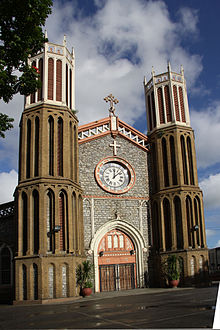Cathedral of the Immaculate Conception (Port of Spain)
The 1832 built Cathedral of the Immaculate Conception ( Cathedral of the Immaculate Conception ) is the oldest Catholic church in the Trinidadian capital Port of Spain . It is the seat of the Archdiocese of Port of Spain .
location
The Cathedral of the Immaculate Conception is located in the eastern part of the elongated Independence Square in the city center (Downtown). At the time of construction, the cathedral was located directly on the banks of the Gulf of Paria ; after several landfills in the 19th century, it is now a good 300 meters inland.
history
Trinidad was originally a colony of Catholic Spain and came under the rule of Protestant England in 1790. Because of the large number of Catholic settlers and the remote location of the colony at the time, there never were any conflicts between Catholics and Protestants. The first Catholic church in Port of Spain was built in 1781 under the Spanish governor Martín de Salaverría at the eastern end of Plaza de la Marina, today's Independence Square. The growing (and majority) Catholic population prompted British Governor Ralph Woodford to plan the construction of a larger church just west of the old church in the early 19th century . The plans were drawn up by Woodford's secretary Philip Reinagle, son of Philip Reinagle . The foundation stone was laid on March 25, 1816.
It took 34 years to build, which was not uncommon for buildings in remote colonies. The funds repeatedly ran out, or the building materials, which were already arriving with a significant delay, were primarily used for the new construction of the Anglican Holy Trinity Cathedral , which burned down in 1808 . In 1820, while it was still under construction, the church was designated as a cathedral by Vicar Apostolic James Buckley . In September 1825 an earthquake struck, which damaged the facade towers of the church; the tips were then rebuilt from wood. In 1832 the construction was essentially completed. Bishop Daniel McDonnell celebrated the first service, although a number of works were still pending. In 1849 a first, small organ was bought. In 1850 the cathedral was finished, the remaining building debts were removed. The cathedral was consecrated on February 22, 1851, in the same year it was opened by Pope Pius IX. raised to the minor basilica . In 1850 the diocese of Port of Spain was elevated to an archdiocese.
In 1879 the clock that is still available today was installed. In 1913 the first organ was replaced by a larger one made by the British company JW Walker & Sons. The current altar was built in 1966. The cathedral was renovated in 1967 after earthquake damage. Another extensive renovation took place from 2012 to 2015. The cathedral was slightly damaged in the earthquake on August 21, 2018 with a magnitude of 6.9 on the moment magnitude scale . After six weeks of repairs, it was reopened in October 2018.
Architectural style and equipment
The cathedral is built in the neo-Gothic style. The floor plan corresponds to a Latin cross , with the entire building measuring 70 by 40 meters and the central nave measuring 24 by 24 meters. The outer walls of the building are made of bricks imported from England and bluestone from laventille that was quarried from a mound just a mile east of the building. The building holds around 1500 worshipers.
In the north aisle is the Chapel of Our Lady (Marienkapelle), in which there is an old altar and a communion bench made of Florentine marble as well as a plaque in memory of the church builder Woodford. In the south aisle is the Chapel of St. Joseph (Chapel of St. Joseph), under which there is a crypt in which members of the cathedral clergy are buried, including the first Archbishop of Port of Spain, Anthony Pantin .
The cathedral is known for its 27 rosettes . Behind the cathedral altar is a stained glass window depicting the Virgin Mary .
The two towers in front of the cathedral together carry twelve bells, most of the gifts from believers from 1831 and 1870.
literature
- Archdiocese of Port of Spain (ed.): Rededication of the Cathedral of the Immaculate Conception . Special Supplement to Catholic News , Port of Spain, December 6, 2015.
Individual evidence
- ^ A b National Trust.tt : The Cathedral of the Immaculate Conception. Retrieved April 6, 2018 .
- ↑ a b c d Milestones . In: Rededication of the Cathedral of the Immaculate Conception . Special Supplement to Catholic News , Port of Spain, December 6, 2015, p. 8.
- ^ Olga J. Mavrogordato: Voices in the Street . Inprint Caribbean, Port of Spain 1977, p. 71.
- ↑ Caroline Taylor: Saving the soul of the city. T & T's historic Catholic Cathedral of the Immaculate Conception is to be restored. In: Caribbean Beat . Caribbean Airlines in-flight magazine, issue 112 (November / December 2011), accessed on September 12, 2017.
- ↑ Cathedral reopens . In: Catholic News , Port of Spain, No. 6584, October 7, 2018, p. 17.
- ↑ Michael Anthony: Historic Landmarks of Port of Spain . Macmillan Caribbean 2008, p. 7.
- ^ Lara Pickford-Gordon: New life in Cathedral “bones” . In: Rededication of the Cathedral of the Immaculate Conception . Special Supplement to Catholic News , Port of Spain, December 6, 2015, p. 5.
Coordinates: 10 ° 38 ′ 59.5 " N , 61 ° 30 ′ 26" W.

